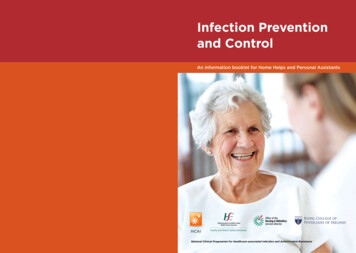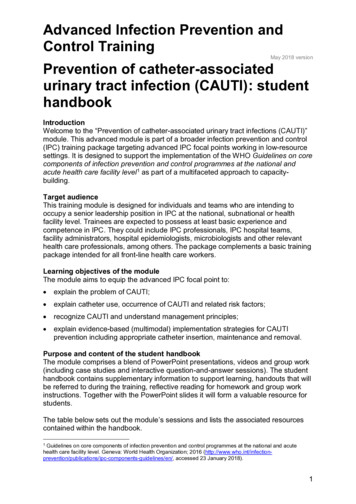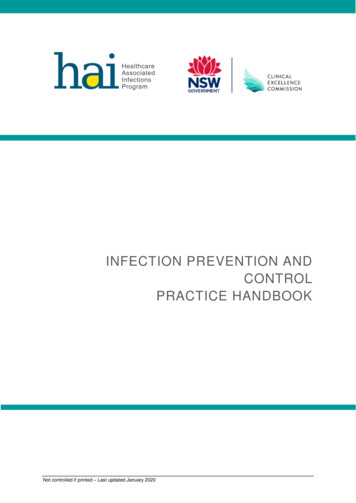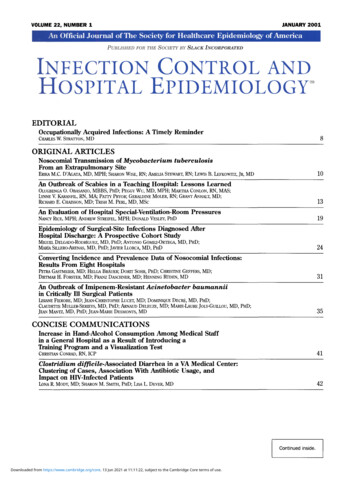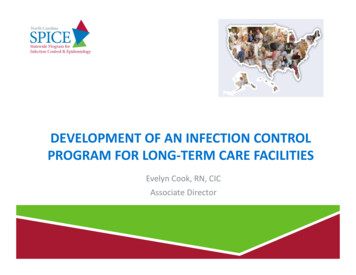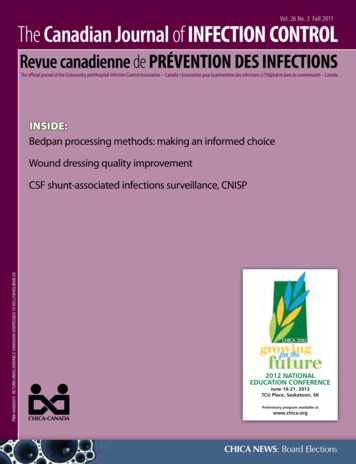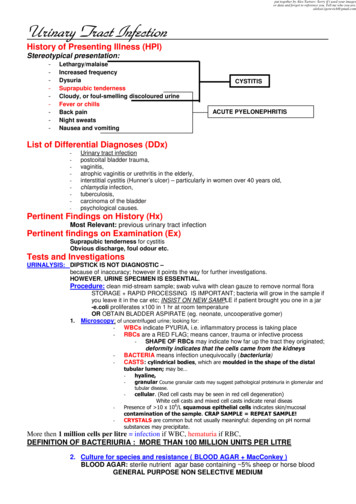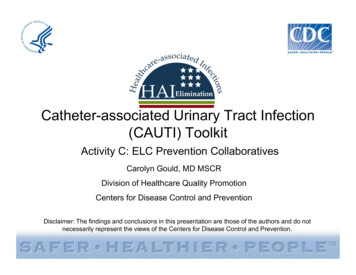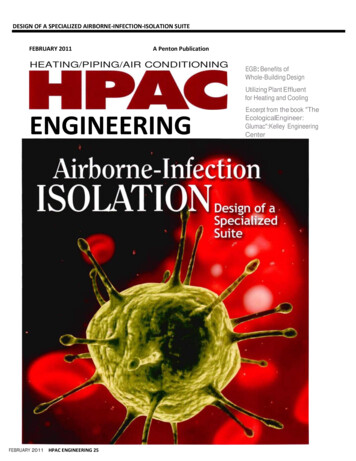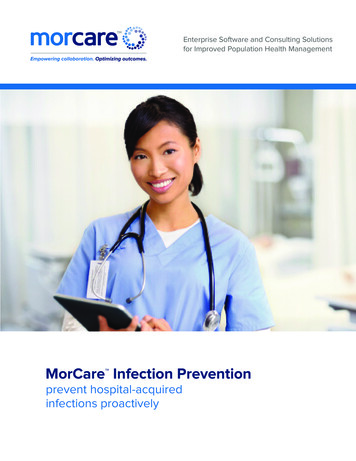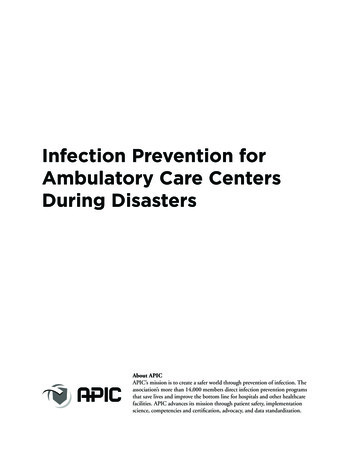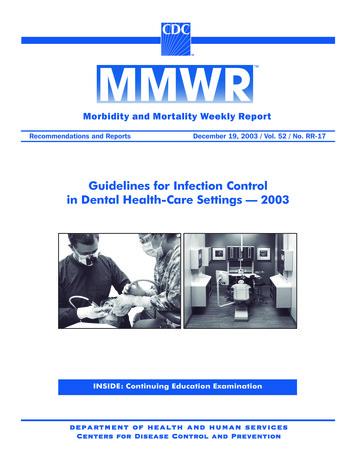
Transcription
Morbidity and Mortality Weekly ReportRecommendations and ReportsDecember 19, 2003 / Vol. 52 / No. RR-17Guidelines for Infection Controlin Dental Health-Care Settings — 2003INSIDE: Continuing Education Examinationdepartment of health and human servicesdepartmentservicesCenters for Disease Control and Prevention
MMWRCONTENTSThe MMWR series of publications is published by theEpidemiology Program Office, Centers for DiseaseControl and Prevention (CDC), U.S. Department ofHealth and Human Services, Atlanta, GA 30333.SUGGESTED CITATIONCenters for Disease Control and Prevention. Guidelinesfor Infection Control in Dental Health-Care Settings— 2003. MMWR 2003;52(No. RR-17):[inclusive pagenumbers].Centers for Disease Control and PreventionJulie L. Gerberding, M.D., M.P.H.DirectorDixie E. Snider, Jr., M.D., M.P.H.(Acting) Deputy Director for Public Health ScienceSusan Y. Chu, Ph.D., M.S.P.H.(Acting) Associate Director for ScienceEpidemiology Program OfficeStephen B. Thacker, M.D., M.Sc.DirectorOffice of Scientific and Health CommunicationsJohn W. Ward, M.D.DirectorEditor, MMWR SeriesSuzanne M. Hewitt, M.P.A.Managing Editor, MMWR SeriesC. Kay Smith-Akin, M.Ed.Lead Technical Writer/EditorC. Kay Smith-Akin, M.Ed.Douglas W. WeatherwaxProject EditorsBeverly J. HollandLead Visual Information SpecialistMalbea A. LaPeteVisual Information SpecialistKim L. Bright, M.B.A.Quang M. Doan, M.B.A.Erica R. ShaverInformation Technology SpecialistsIntroduction . 1Background . 2Previous Recommendations . 3Selected Definitions . 4Review of Science Related to Dental Infection Control . 6Personnel Health Elements of an Infection-ControlProgram . 6Preventing Transmissionof Bloodborne Pathogens . 10Hand Hygiene . 14Personal Protective Equipment . 16Contact Dermatitis and Latex Hypersensitivity . 19Sterilization and Disinfection of Patient-Care Items . 20Environmental Infection Control . 25Dental Unit Waterlines, Biofilm, and Water Quality . 28Special Considerations . 30Dental Handpieces and Other Devices Attachedto Air and Waterlines . 30Saliva Ejectors . 31Dental Radiology . 31Aseptic Technique for Parenteral Medications . 31Single-Use or Disposable Devices . 32Preprocedural Mouth Rinses . 32Oral Surgical Procedures . 32Handling of Biopsy Specimens . 33Handling of Extracted Teeth . 33Dental Laboratory . 33Laser/Electrosurgery Plumes or Surgical Smoke . 34M. tuberculosis . 35Creutzfeldt-Jakob Disease and Other Prion Diseases . 36Program Evaluation . 37Infection-Control Research Considerations . 38Recommendations . 39Infection-Control Internet Resources . 48Acknowledgement . 48References . 48Appendix A . 62Appendix B . 65Appendix C . 66Continuing Education Activity* . CE-1* For Continuing Dental Education (CDE), see http://www.ada.org.To request additional copies of this report, contact CDC's Divisionof Oral Health by e-mail: oralhealth@cdc.gov; telephone: 770-4886054; or fax: 770-488-6080.Disclosure of RelationshipOur subject matter experts wish to disclose they have no financialinterests or other relationships with the manufacture of commercialproducts, providers of commercial services, or commercial supporters.This report does not include any discussion of the unlabeled use ofcommercial products or products for investigational use.
Vol. 52 / RR-17Recommendations and Reports1Guidelines for Infection Controlin Dental Health-Care Settings — 2003Prepared byWilliam G. Kohn, D.D.S.1Amy S. Collins, M.P.H.1Jennifer L. Cleveland, D.D.S.1Jennifer A. Harte, D.D.S.2Kathy J. Eklund, M.H.P.3Dolores M. Malvitz, Dr.P.H.11Division of Oral HealthNational Center for Chronic Disease Prevention and Health Promotion, CDC2United States Air Force Dental Investigation ServiceGreat Lakes, Illinois3The Forsyth InstituteBoston, MassachusettsSummaryThis report consolidates previous recommendations and adds new ones for infection control in dental settings. Recommendationsare provided regarding 1) educating and protecting dental health-care personnel; 2) preventing transmission of bloodborne pathogens; 3) hand hygiene; 4) personal protective equipment; 5) contact dermatitis and latex hypersensitivity; 6) sterilization anddisinfection of patient-care items; 7) environmental infection control; 8) dental unit waterlines, biofilm, and water quality; and9) special considerations (e.g., dental handpieces and other devices, radiology, parenteral medications, oral surgical procedures, anddental laboratories). These recommendations were developed in collaboration with and after review by authorities on infectioncontrol from CDC and other public agencies, academia, and private and professional organizations.IntroductionThis report consolidates recommendations for preventingand controlling infectious diseases and managing personnelhealth and safety concerns related to infection control in dental settings. This report 1) updates and revises previous CDCrecommendations regarding infection control in dental settings (1,2); 2) incorporates relevant infection-control measuresfrom other CDC guidelines; and 3) discusses concerns notaddressed in previous recommendations for dentistry. Theseupdates and additional topics include the following: application of standard precautions rather than universalprecautions; work restrictions for health-care personnel (HCP) infectedwith or occupationally exposed to infectious diseases; management of occupational exposures to bloodbornepathogens, including postexposure prophylaxis (PEP) forwork exposures to hepatitis B virus (HBV), hepatitis Cvirus (HCV); and human immunodeficiency virus (HIV); selection and use of devices with features designed to prevent sharps injury;The material in this report originated in the National Center for ChronicDisease Prevention and Health Promotion, James S. Marks, M.D.,M.P.H., Director; and the Division of Oral Health, William R. Maas,D.D.S., M.P.H., Director. hand-hygiene products and surgical hand antisepsis;contact dermatitis and latex hypersensitivity;sterilization of unwrapped instruments;dental water-quality concerns (e.g., dental unit waterlinebiofilms; delivery of water of acceptable biological qualityfor patient care; usefulness of flushing waterlines; use ofsterile irrigating solutions for oral surgical procedures;handling of community boil-water advisories); dental radiology; aseptic technique for parenteral medications; preprocedural mouth rinsing for patients; oral surgical procedures; laser/electrosurgery plumes; tuberculosis (TB); Creutzfeldt-Jakob disease (CJD) and other prion-relateddiseases; infection-control program evaluation; and research considerations.These guidelines were developed by CDC staff members incollaboration with other authorities on infection control. Draftdocuments were reviewed by other federal agencies and professional organizations from the fields of dental health care, publichealth, and hospital epidemiology and infection control. A Federal Register notice elicited public comments that were considered in the decision-making process. Existing guidelines andpublished research pertinent to dental infection-control prin-
2MMWRciples and practices were reviewed. Wherever possible, recommendations are based on data from well-designed scientific studies. However, only a limited number of studies have characterizedrisk factors and the effectiveness of prevention measures forinfections associated with dental health-care practices.Some infection-control practices routinely used by healthcare practitioners cannot be rigorously examined for ethical orlogistical reasons. In the absence of scientific evidence for suchpractices, certain recommendations are based on strong theoretical rationale, suggestive evidence, or opinions of respectedauthorities based on clinical experience, descriptive studies, orcommittee reports. In addition, some recommendations arederived from federal regulations. No recommendations areoffered for practices for which insufficient scientific evidenceor lack of consensus supporting their effectiveness exists.BackgroundIn the United States, an estimated 9 million persons work inhealth-care professions, including approximately 168,000 dentists, 112,000 registered dental hygienists, 218,000 dentalassistants (3), and 53,000 dental laboratory technicians (4).In this report, dental health-care personnel (DHCP) refers toall paid and unpaid personnel in the dental health-care settingwho might be occupationally exposed to infectious materials,including body substances and contaminated supplies, equipment, environmental surfaces, water, or air. DHCP includedentists, dental hygienists, dental assistants, dental laboratorytechnicians (in-office and commercial), students and trainees,contractual personnel, and other persons not directly involvedin patient care but potentially exposed to infectious agents (e.g.,administrative, clerical, housekeeping, maintenance, or volunteer personnel). Recommendations in this report aredesigned to prevent or reduce potential for disease transmission from patient to DHCP, from DHCP to patient, and frompatient to patient. Although these guidelines focus mainly onoutpatient, ambulatory dental health-care settings, the recommended infection-control practices are applicable to all settings in which dental treatment is provided.Dental patients and DHCP can be exposed to pathogenicmicroorganisms including cytomegalovirus (CMV), HBV,HCV, herpes simplex virus types 1 and 2, HIV, Mycobacterium tuberculosis, staphylococci, streptococci, and other virusesand bacteria that colonize or infect the oral cavity and respiratory tract. These organisms can be transmitted in dental settings through 1) direct contact with blood, oral fluids, or otherpatient materials; 2) indirect contact with contaminatedobjects (e.g., instruments, equipment, or environmental surfaces); 3) contact of conjunctival, nasal, or oral mucosa withDecember 19, 2003droplets (e.g., spatter) containing microorganisms generatedfrom an infected person and propelled a short distance (e.g.,by coughing, sneezing, or talking); and 4) inhalation of airborne microorganisms that can remain suspended in the airfor long periods (5).Infection through any of these routes requires that all of thefollowing conditions be present: a pathogenic organism of sufficient virulence and inadequate numbers to cause disease; a reservoir or source that allows the pathogen to surviveand multiply (e.g., blood); a mode of transmission from the source to the host; a portal of entry through which the pathogen can enterthe host; and a susceptible host (i.e., one who is not immune).Occurrence of these events provides the chain of infection (6).Effective infection-control strategies prevent disease transmission by interrupting one or more links in the chain.Previous CDC recommendations regarding infection control for dentistry focused primarily on the risk of transmissionof bloodborne pathogens among DHCP and patients and useof universal precautions to reduce that risk (1,2,7,8). Universal precautions were based on the concept that all blood andbody fluids that might be contaminated with blood should betreated as infectious because patients with bloodborne infections can be asymptomatic or unaware they are infected (9,10).Preventive practices used to reduce blood exposures, particularly percutaneous exposures, include 1) careful handling ofsharp instruments, 2) use of rubber dams to minimize bloodspattering; 3) handwashing; and 4) use of protective barriers(e.g., gloves, masks, protective eyewear, and gowns).The relevance of universal precautions to other aspects ofdisease transmission was recognized, and in 1996, CDCexpanded the concept and changed the term to standard precautions. Standard precautions integrate and expand the elements of universal precautions into a standard of care designedto protect HCP and patients from pathogens that can be spreadby blood or any other body fluid, excretion, or secretion (11).Standard precautions apply to contact with 1) blood; 2) allbody fluids, secretions, and excretions (except sweat), regardless of whether they contain blood; 3) nonintact skin; and 4)mucous membranes. Saliva has always been considered apotentially infectious material in dental infection control; thus,no operational difference exists in clinical dental practicebetween universal precautions and standard precautions.In addition to standard precautions, other measures (e.g.,expanded or transmission-based precautions) might be necessary to prevent potential spread of certain diseases (e.g., TB,influenza, and varicella) that are transmitted through airborne,
Vol. 52 / RR-17Recommendations and Reportsdroplet, or contact transmission (e.g., sneezing, coughing, andcontact with skin) (11). When acutely ill with these diseases,patients do not usually seek routine dental outpatient care.Nonetheless, a general understanding of precautions for diseases transmitted by all routes is critical because 1) some DHCPare hospital-based or work part-time in hospital settings;2) patients infected with these diseases might seek urgent treatment at outpatient dental offices; and 3) DHCP mightbecome infected with these diseases. Necessary transmissionbased precautions might include patient placement (e.g., isolation), adequate room ventilation, respiratory protection (e.g.,N-95 masks) for DHCP, or postponement of nonemergencydental procedures.DHCP should be familiar also with the hierarchy of controls that categorizes and prioritizes prevention strategies (12).For bloodborne pathogens, engineering controls that eliminate or isolate the hazard (e.g., puncture-resistant sharps containers or needle-retraction devices) are the primary strategiesfor protecting DHCP and patients. Where engineering controls are not available or appropriate, work-practice controlsthat result in safer behaviors (e.g., one-hand needle recappingor not using fingers for cheek retraction while using sharpinstruments or suturing), and use of personal protective equipment (PPE) (e.g., protective eyewear, gloves, and mask) canprevent exposure (13). In addition, administrative controls(e.g., policies, procedures, and enforcement measures targetedat reducing the risk of exposure to infectious persons) are apriority for certain pathogens (e.g., M. tuberculosis), particularly those spread by airborne or droplet routes.Dental practices should develop a written infection-controlprogram to prevent or reduce the risk of disease transmission.Such a program should include establishment and implementation of policies, procedures, and practices (in conjunctionwith selection and use of technologies and products) to prevent work-related injuries and illnesses among DHCP as wellas health-care–associated infections among patients. The program should embody principles of infection control andoccupational health, reflect current science, and adhere to relevant federal, state, and local regulations and statutes. Aninfection-control coordinator (e.g., dentist or other DHCP)knowledgeable or willing to be trained should be assignedresponsibility for coordinating the program. The effectivenessof the infection-control program should be evaluated on a dayto-day basis and over time to help ensure that policies, procedures, and practices are useful, efficient, and successful (seeProgram Evaluation).Although the infection-control coordinator remains responsible for overall management of the program, creating and maintaining a safe work environment ultimately requires the3commitment and accountability of all DHCP. This report isdesigned to provide guidance to DHCP for preventing diseasetransmission in dental health-care settings, for promoting a safeworking environment, and for assisting dental practices indeveloping and implementing infection-control programs. Theseprograms should be followed in addition to practices and procedures for worker protection required by the OccupationalSafety and Health Administration’s (OSHA) standards foroccupational exposure to bloodborne pathogens (13),including instituting controls to protect employees fromexposure to blood or other potentially infectious materials(OPIM), and requiring implementation of a written exposurecontrol plan, annual employee training, HBV vaccinations, andpostexposure follow-up (13). Interpretations and enforcementprocedures are available to help DHCP apply this OSHA standard in practice (14). Also, manufacturer’s Material Safety DataSheets (MSDS) should be consulted regarding correct procedures for handling or working with hazardous chemicals (15).Previous RecommendationsThis report includes relevant infection-control measures fromthe following previously published CDC guidelines and recommendations: CDC. Guideline for disinfection and sterilization inhealth-care facilities: recommendations of CDC and theHealthcare Infection Control Practices Advisory Committee (HICPAC). MMWR (in press). CDC. Guidelines for environmental infection control inhealth-care facilities: recommendations of CDC and theHealthcare Infection Control Practices Advisory Committee (HICPAC). MMWR 2003;52(No. RR-10). CDC. Guidelines for the prevention of intravascularcatheter-related infections. MMWR 2002;51(No. RR-10). CDC. Guideline for hand hygiene in health-care settings:recommendations of the Healthcare Infection ControlPractices Advisory Committee and the HICPAC/SHEA/APIC/IDSA Hand Hygiene Task Force. MMWR 2002;51(No. RR-16). CDC. Updated U.S. Public Health Service guidelines forthe management of occupational exposures to HBV, HCV,and HIV and recommendations for postexposure prophylaxis. MMWR 2001;50(No. RR-11). Mangram AJ, Horan TC, Pearson ML, Silver LC, JarvisWR, Hospital Infection Control Practices Advisory Committee. Guideline for prevention of surgical site infection,1999. Infect Control Hosp Epidemiol 1999;20:250–78. Bolyard EA, Tablan OC, Williams WW, Pearson ML,Shapiro CN, Deitchman SD, Hospital Infection ControlPractices Advisory Committee. Guideline for infection
4MMWR control in health care personnel, 1998. Am J Infect Control 1998;26:289–354.CDC. Immunization of health-care workers: recommendations of the Advisory Committee on Immunization Practices (ACIP) and the Hospital Infection Control PracticesAdvisory Committee (HICPAC). MMWR 1997;46(No.RR-18).Rutala WA, Assoc
9) special considerations (e.g., dental handpieces and other devices, radiology, parenteral medications, oral surgical procedur es, and dental laboratories). These recommendations were developed in collab
